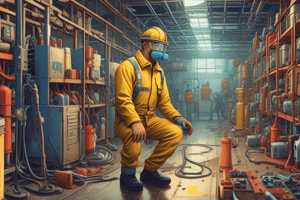Podcast
Questions and Answers
What is the purpose of stipulating the Occupational Safety and Health Ordinance?
What is the purpose of stipulating the Occupational Safety and Health Ordinance?
To protect the safety and health of employees at work.
Which of the following is a main pathway for chemical substances to enter a worker's body? (Select all that apply)
Which of the following is a main pathway for chemical substances to enter a worker's body? (Select all that apply)
- Inhalation (correct)
- Skin contact (correct)
- Touching
- Swallowing (correct)
The minimum width of a working platform is ______ mm.
The minimum width of a working platform is ______ mm.
400
Employers should contribute to safety and health by ensuring employees take care of others' safety.
Employers should contribute to safety and health by ensuring employees take care of others' safety.
What should be provided for a construction site with 100 or more workers?
What should be provided for a construction site with 100 or more workers?
When should a dangerous occurrence in the workplace be reported to the Labour Department?
When should a dangerous occurrence in the workplace be reported to the Labour Department?
What must the wording 'first aid' indicate on a first aid box?
What must the wording 'first aid' indicate on a first aid box?
What is the main function of guardrails on a working platform?
What is the main function of guardrails on a working platform?
What should be done when a worker falls from height?
What should be done when a worker falls from height?
What is a requirement for scaffolds on a construction site?
What is a requirement for scaffolds on a construction site?
How far should the top of a ladder protrude from the landing platform?
How far should the top of a ladder protrude from the landing platform?
Flashcards are hidden until you start studying
Study Notes
General Safety
- Purpose of the Occupational Safety and Health Ordinance is employee protection at work.
- Employers and employees share responsibility for workplace safety; both must prioritize safety and health.
- Proprietors must ensure safe working environments, provide safety information, training, and supervision, and ensure safe access to workspaces.
- Chemical exposure routes include swallowing, skin contact, and inhalation; proper handling is critical.
- Proper identification of chemicals requires reading labels, which must include a chemical name, classification, risks, and safety precautions.
- Chemicals are classified as explosive, oxidizing, flammable, toxic, harmful, corrosive, and irritant; protective gear is essential when handling.
- Construction site safety practices include:
- Proper storage of materials and avoidance of floor openings.
- No throwing materials from heights or working near edges without guardrails.
- Keeping passageways clear and addressing timber hazards.
- Use of eye protection during welding.
- Avoid working under suspended loads.
- Construction sites with 5+ workers need a designated first aid box with appropriate markings and resources.
- For 30-99 workers, a trained first aid responder is required; 100+ workers necessitate a full-time safety officer.
- Employers must provide potable water and report dangerous occurrences to the Labour Department within 24 hours.
- "Mandatory Safety Training" must be recognized by the Commissioner for Labour.
Work at Height
- Fatal accidents in construction often occur from working at height; prioritize using working platforms for safety.
- Only trained personnel should erect scaffolds, which must be inspected by a competent person and certified safe every two weeks.
- Safety features of working platforms include guardrails to prevent falls and toeboards to keep objects from falling.
- Minimum working platform width is 400mm; guardrail height ranges from 900-1150mm, and toeboards must be at least 200mm tall.
- Safety harnesses must be secured to suitable anchorages or independent lifelines when used to prevent falls.
- For scaffold maintenance at heights, an independent lifeline is the best anchorage method; harness should be attached above waist level.
- At least 3 bolts are required to secure each metal bracket of truss-out scaffolds to buildings.
- Ladders must be stable, placed on solid ground, and should not be joined; they must extend at least 1.0 meter above the landing.
- Workers on gondolas must wear safety belts attached to independent lifelines.
- Cages or receptacles for carrying persons must be a minimum of 900mm deep.
- In the event of a fall, notify first aid immediately and do not move the injured person.
- Scaffolds should have safe access and egress for cleaning work at height.
- Ladders require regular inspections and maintenance for safety.
- When installing electrical conduits at height, a suitable platform with guardrails and toe-boards is necessary.
Studying That Suits You
Use AI to generate personalized quizzes and flashcards to suit your learning preferences.




